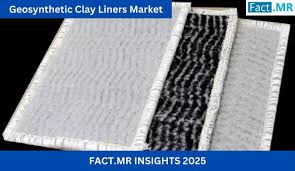Geosynthetic Clay Liners Market is Expected to Reach at USD 791.7 million by 2035 | Fact.MR

Analysis of Geosynthetic Clay Liners Market Covering 30+ Countries Including Analysis of US, Canada, UK, Germany, France, Nordics, GCC countries, Japan, Korea
ROCKVILLE, MD, UNITED STATES, June 10, 2025 /EINPresswire.com/ -- The Geosynthetic Clay Liner (GCL) market will be USD 552.8 million by 2025 with an estimated CAGR of 7.9% and will reach USD 1.2 billion by 2035. The key growth driver will be the rise in environmental containment technology demand for mining, waste, and water infrastructure building works. GCLs, which have bentonite clay wrapped around geotextile layers, are being used more frequently due to their improved sealing property, easy installation, and comparative affordability to the traditional compacted clay liners. The number of environmental regulations and stringent standards from environmental authorities are promoting the application of GCLs to landfill caps, secondary containment, and leachate collection systems.Technology enhancements such as the improvement in needle-punched fabric technology and autonomous deployment technology also propel the market forward, featuring enhanced performance, precise installation and lower dependence on labor. North America leads the market with investments in remediation infrastructure of waste and mines and Asia-Pacific also proves to be a strong contender founded on industrialization and urbanization.
For More Insights into the Market, Request a Sample of this Report: https://www.factmr.com/connectus/sample?flag=S&rep_id=2028
Growth Drivers Driving Market Growth
The geosynthetic clay liner market is increasing at a rapid rate as a measure of the increasing need for environmental containment. With growing regulations of dangerous waste and landfilling, businesses are implementing GCLs since they have improved sealing strength and long-term economic viability. The application of GCLs in mining tailings and hazardous waste containment is also beneficial for chemical resistance and self-healing properties that provide permanent strength in aggressive environments.
Technological advancements also play a significant role, as technologies such as automated deployment systems and composite strength-reinforced layers have improved the hydraulic capacity and strength of GCLs. Furthermore, increasing focus on sustainability is pressurizing companies to use green infrastructure options, which will keep propelling the market. The convergence of technological innovations and regulatory forces will more than likely drive the application of GCLs across various industries, particularly waste management, water storage, and mining activities.
Regional Insights
North America remains the largest market for geosynthetic clay liners because of the robust regulatory environment and significant investment in waste management and landfill capping schemes. Europe is second, with supportive demand for eco-friendly-driven and environmental restoration schemes, particularly in EU-controlled economies. Asia-Pacific is, on the other hand, seeing positive demand, particularly in China, India, and Southeast Asia, driven by industrialization, urbanization, and conservation. As the development of infrastructure accelerates, the region is likely to witness heavy utilization of geosynthetic clay liners, with major projects focusing on landfill activities and water storage facilities.
Key Takeaways from the Market Study
The geosynthetic clay liner market is projected to reach USD 1.2 billion by 2035.
The market will grow at a CAGR of 7.9% during the forecast period.
North America is the leading region for GCL adoption, followed by Europe.
Mining and waste management industries are the primary drivers of demand.
Survey Insights and Stakeholder Priorities
Stakeholder responses to the Geosynthetic Clay Liner market indicate that environmental compliance, longevity of performance and installation effectiveness are the most critical parameters influencing purchasing decisions. 81% of stakeholders highlighted long-term containment solutions that are compliant with environmental mandates, particularly in mining and landfill activities. The growing requirement for flexibility to diverse site conditions and cost benefits over the lifecycle was also highlighted as key drivers of decisions. North America is leading with a focus on groundwater conservation and EPA standards, while Europe is focusing on sustainability and circular production. Within the Asia-Pacific region, stakeholders are focusing on product stability at high temperatures and simple application processes to meet the needs of the area.
Get Customization on this Report for Specific Research Solutions: https://www.factmr.com/connectus/sample?flag=S&rep_id=2028
Companies Targeting Global Environmental Challenges
GSE Environmental is a market leader with 18–22% of the global GCL market share. The company has a global manufacturing footprint and specializes in high-performance GCLs for water containment, mining, and landfills. CETCO (Minerals Technologies Inc.) is a market leader with sodium bentonite and polymer-enhanced GCL products. NAUE GmbH & Co. KG is well established within Europe, manufacturing high-performance GCL systems for civil engineering and environmental applications. HUESKER Synthetic GmbH focuses on providing composite GCLs for green infrastructure projects, and they are accepted in Europe as well as South America.
Regional competitors such as Layfield Group and Terrafix Geosynthetics cater to North American markets, and Geofabrics Australasia and Global Synthetics cater to Australia and New Zealand. These companies are capitalizing on regional infrastructure projects and green engineering initiatives to expand their market share.
Segmental Insights
The geosynthetic clay liner market is divided into sodium bentonite-based and polymer-modified GCLs. Sodium bentonite-based GCLs are anticipated to dominate the market share with 65% in 2025 due to their self-healing properties and permeability level. These liners perform best in landfills, mining, and hydrology use. Polymer-modified GCLs, which also constitute 35% of the market, offer superior chemical resistance and mechanical performance since they can handle toxic chemicals and have a high saline content environment, making them suitable for wastewater ponds and mining leach pads.
Check out More Related Studies Published by Fact.MR:
Clay absorber market size is estimated at US$ 4.42 billion in 2024 and has been forecasted to expand at a CAGR of 4.2% to end up at a value of US$ 6.67 billion by 2034.
Global bleaching clay market is projected to be valued at US$ 1.07 billion in 2024 and thereafter expand at a noteworthy CAGR of 7.3%
S. N. Jha
Fact.MR
+1 628-251-1583
email us here
Legal Disclaimer:
EIN Presswire provides this news content "as is" without warranty of any kind. We do not accept any responsibility or liability for the accuracy, content, images, videos, licenses, completeness, legality, or reliability of the information contained in this article. If you have any complaints or copyright issues related to this article, kindly contact the author above.
Hayden Foundation of Rhode Island Sees Record Grant Applications, Reflecting Growing Education and Animal Welfare Needs
Second Heart Assist's Whisper Device Poised to Advance AHA CKM Goals with Breakthrough Heart–Kidney Support
Be a Better Leader: A Situational Guide with Practical Tools to Empower Leaders at All Levels for Effective Leadership
Więcej ważnych informacji
 Jedynka Newserii
Jedynka Newserii

 Jedynka Newserii
Jedynka Newserii

Konsument

Polacy nie korzystają z hossy trwającej na warszawskiej giełdzie. Na wzrostach zarabiają głównie inwestorzy zagraniczni
Od października 2022 roku na rynkach akcji trwa hossa, nie omija ona także warszawskiej giełdy. Mimo to inwestorzy indywidualni odpowiadają zaledwie za kilkanaście procent inwestycji, a o wzrostach decyduje i na nich zarabia głównie kapitał z zagranicy. Widać to również po napływach i odpływach do i z funduszy inwestycyjnych. Zdaniem Tomasza Koraba, prezesa EQUES Investment TFI, do przekonania Polaków do inwestowania na rodzimej giełdzie potrzeba zysków z akcji, informacji o tych zyskach docierającej do konsumentów oraz czasu.
Polityka
Obowiązek zapełniania magazynów gazu w UE przed sezonem zimowym ma zapewnić bezpieczeństwo dostaw. Wpłynie też na stabilizację cen

Unia Europejska przedłuży przepisy z 2022 roku dotyczące magazynowania gazu. Będą one obowiązywać do końca 2027 roku. Zobowiązują one państwa członkowskie do osiągnięcia określonego poziomu zapełnienia magazynów gazu przed sezonem zimowym. Magazyny gazu pokrywają 30 proc. zapotrzebowania Unii Europejskiej na niego w miesiącach zimowych. Nowe unijne przepisy mają zapewnić stabilne i przystępne cenowo dostawy.
Infrastruktura
Gminy zwlekają z uchwaleniem planów ogólnych zagospodarowania przestrzennego. Może to spowodować przesunięcie terminu ich wejścia w życie

Reforma systemu planowania i zagospodarowania przestrzennego rozpoczęła się we wrześniu 2023 roku wraz z wejściem w życie większości przepisów nowelizacji ustawy z 27 marca 2003 roku. Uwzględniono w niej plany ogólne gminy (POG) – nowe dokumenty planistyczne, za których przygotowanie mają odpowiadać samorządy. Rada Ministrów w kwietniu br. uchwaliła jednak ustawę o zmianie ustawy z 7 lipca 2023 roku, a jej celem jest zmiana terminu obowiązywania studiów uwarunkowań i kierunków zagospodarowania przestrzennego gmin na 30 czerwca 2026 roku. Wskazana data może nie być ostateczna z uwagi na to, że żadna z gmin nie uchwaliła jeszcze POG.
Partner serwisu
Szkolenia

Akademia Newserii
Akademia Newserii to projekt, w ramach którego najlepsi polscy dziennikarze biznesowi, giełdowi oraz lifestylowi, a także szkoleniowcy z wieloletnim doświadczeniem dzielą się swoją wiedzą nt. pracy z mediami.








.gif)

 |
| |
| |
|